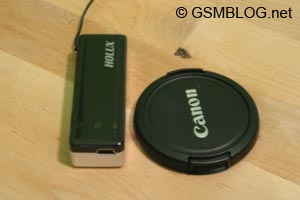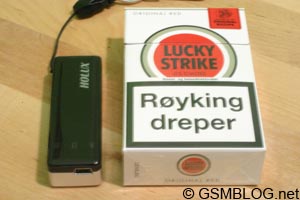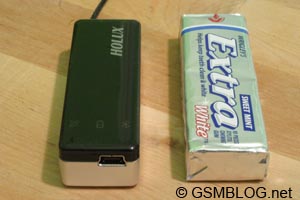Holux GR-240 test - part 1
A couple of days ago I finally received the Holux GR-240 I ordered ages ago. I've now run it through a couple of short test, so it's time to write my first review on this new fancy device.
Before I get started there are a couple of things I have to mention. First of all my previous GPS was the Holux GR-230, a non SIRFIII GPS, so my comparisons might not be quite fair. For the second I live in Norway, located quite far north compared to the GPS satellites orbits, so all GPS units perform worse here than further south. Last I have to mention that I mostly use my GPS for tracking and logging purposes, so for the moment at least I will not be testing it with navigation software.
The tests were performed with the Holux GR-230 GPS and a Nokia N80 running AFTrack software.
This is an initial test of the GPS. I will be making updates to the test as time goes by. I'm also planning on testing the performance of the GR-230 vs. the GR-240 next time I go for a long drive. I'll set up both GPS units next to each other in the window each hooked up to their own cell phone and see how they perform compared to each other.
First impression
 The size of the Holux GR-240 GPS is amazing. It's fabulous. It's marvelous. In other words I really liked the size. It's the size of a pack of gum, maybe a little thicker. It fits perfectly in the watch pocket of your jeans. It's also small enough that it can easily be used as a keychain, so you'll always have your GPS with you no matter where you go. When I use the GPS while walking I have it on a cord around my neck. It works out perfectly. The GR-230 was to large for doing that seeing as it started annoying me with it's banging on my chest quite quickly. Normally I just fastened it to my backpack, if I had one. If I didn't I just carried it in my hand. The GR-240 eliminates that problem.
The size of the Holux GR-240 GPS is amazing. It's fabulous. It's marvelous. In other words I really liked the size. It's the size of a pack of gum, maybe a little thicker. It fits perfectly in the watch pocket of your jeans. It's also small enough that it can easily be used as a keychain, so you'll always have your GPS with you no matter where you go. When I use the GPS while walking I have it on a cord around my neck. It works out perfectly. The GR-230 was to large for doing that seeing as it started annoying me with it's banging on my chest quite quickly. Normally I just fastened it to my backpack, if I had one. If I didn't I just carried it in my hand. The GR-240 eliminates that problem.
The design is much nicer than my previous GPS. The Holux GR-240 is small and shiny. It's mainly silver colored plastic, but the front is made of semi-translucent black plastic with the word HOLUX imprinted in silver and three color LED indicators at the bottom. My previous GPS was basically an ugly clump of black plastic, and everybody asked what it was. The GR-240 is a small shiny thing, that easily could be a memory stick or a mp3 player. The only negative bit with the design is the blinking LED indicators at the bottom. In bright sunshine they are perfect because their bright enough to be seen, but when it's dark out they are way too bright and make me feel like a walking Christmas-tree. This could easily have been rectified with a light sensor, but that would however have made this fairly expensive device even more expensive. When I say expensive it's relative. My previous GPS was more than double as expensive when I bought it, but the GR-240 is still quite expensive if you compare it to other, larger models available.
Initial testing
 First thing I did after fully charging the GPS (I was surprised to learn that there actually was power on my GPS when I received it, probably from testing, but I decided to fully charge it before testing it) was turn it on and put it in a windowsill. I was delighted to see that it got a fix (weak, but still a fix) after only a couple of minutes. My previous GPS used at least 15 minutes, normally much longer to get a fix in the same windowsill.
First thing I did after fully charging the GPS (I was surprised to learn that there actually was power on my GPS when I received it, probably from testing, but I decided to fully charge it before testing it) was turn it on and put it in a windowsill. I was delighted to see that it got a fix (weak, but still a fix) after only a couple of minutes. My previous GPS used at least 15 minutes, normally much longer to get a fix in the same windowsill.
After turning it off for a while I tried hanging it around my neck and going out on the balcony for a smoke. The unit got a weak fix after only a few minutes. This surprised me seeing as there is another balcony above mine that blocks the view to the sky. Normally when I was going somewhere I would put my old GPS all the way at the edge of the balcony for at least 20 minutes before leaving, to make sure I got a fix.
 The next thing I did was take the GPS out for a walk downtown Oslo. I stood for a couple of minutes on the street before getting a fix. After I realized I was under a tree I moved a couple of meters and got a fix. My old GPS didn't perform very well when I used to go for walks downtown Oslo, and unfortunately neither did my new one. This is due to high buildings and trees. The whole walk the GPS skipped between 3 and 5 satellites, not exactly impressive. I had the GPS on both outdoors and indoors for over 4 ours, and when I got home the battery still was more than 50% charged. It only took about 15 minutes to fully charge the battery after returning home. This is a huge improvement compared to my old GPS that would have gone dry before 4 hours had passed.
The next thing I did was take the GPS out for a walk downtown Oslo. I stood for a couple of minutes on the street before getting a fix. After I realized I was under a tree I moved a couple of meters and got a fix. My old GPS didn't perform very well when I used to go for walks downtown Oslo, and unfortunately neither did my new one. This is due to high buildings and trees. The whole walk the GPS skipped between 3 and 5 satellites, not exactly impressive. I had the GPS on both outdoors and indoors for over 4 ours, and when I got home the battery still was more than 50% charged. It only took about 15 minutes to fully charge the battery after returning home. This is a huge improvement compared to my old GPS that would have gone dry before 4 hours had passed.
I also took a ride on the streetcar (tram for you Brits out there). I was impressed that the GPS performed fine just hanging around my neck. My old GPS had to be placed up against the window for it to work on streetcars.
The next day I decided to see what happened if I started moving before getting a fix. Now the GPS performed just as bad as my old GPS. It never got a fix for the 20 minutes I was out walking. Coming home I made sure I had a fix before I started walking. Previous experiences with the GR-240 showed me that it normally regained a fix quite quickly after entering a building. But now I went into a store for a few minutes, and after coming back out it just wouldn't get a fix. I walked out onto an empty space, and stood there for a few minutes. Still the GPS kept skipping between 0 and 3 satellites. Just for the heck of it I tried turning the unit on and off quickly, quickly enough that the BlueTooth connection wasn't lost. To my surprise the GPS suddenly had a fix on 9 satellites and skipped between 8 and 9 satellites all the way home. Either it was just dumb luck, or it might have something to do with the low power SIRFIII chipset on this device. My first thought was that it used more power to try to gain a fix when it's shut completely off than when it's not had a fix. I'll have to run more tests to determine if this is the case or not.
That's just about all the testing I've done so far. I'll be running several other tests over the next couple of weeks, and posting the results here.
 This is the first unit shipped from Holux (as far as I know) that only comes with a car charger. My previous unit had both a car charger and a 240V charger. This really isn't a problem for me, seeing as the unit charges via USB. This is really great, seeing as it means as long as you have a computer with power around you can charge your GPS. You use the same USB cable with the car charger simply by plugging the cable into the charger. Seeing as Holux always has had the charge via USB policy, the 240V charger from my old unit worked with my new unit also. The best part about the unit being charged via USB is that you can use any charger from any unit that charges via USB. More and more units like cell phones and PDAs are charge via USB these days. If you are lucky you already have a cradle in your car that charges your cell phone or your PDA, so when your GPS gets power hungry, just slip it in the cradle.
This is the first unit shipped from Holux (as far as I know) that only comes with a car charger. My previous unit had both a car charger and a 240V charger. This really isn't a problem for me, seeing as the unit charges via USB. This is really great, seeing as it means as long as you have a computer with power around you can charge your GPS. You use the same USB cable with the car charger simply by plugging the cable into the charger. Seeing as Holux always has had the charge via USB policy, the 240V charger from my old unit worked with my new unit also. The best part about the unit being charged via USB is that you can use any charger from any unit that charges via USB. More and more units like cell phones and PDAs are charge via USB these days. If you are lucky you already have a cradle in your car that charges your cell phone or your PDA, so when your GPS gets power hungry, just slip it in the cradle.
One more thing needs to be mentioned. After turning on the device you have to wait for a couple (the user manual says 5, but my experience is 2-3) seconds before establishing a BlueTooth connection. The device obviously runs a self diagnosis during start. This isn't really a problem, but you still have to be aware of it.
Conclusion
The Holux GR-240 design is amazing. Best I've seen so far. I really love this GPS, and it's always going to be with me. My previous GPS I only took along when I knew I was going to use it. The GR-240 goes with me every time I leave the apartment, just in case I decide to use it.
The Holux GR-240 performs so much better than my previous GPS that it's basically an unfair comparison. It still seems that GPS unites have their strange quirks, like the need to ensure you have a fix before moving. I am really looking forward to seeing how this GPS performs in the future. The battery on this thing is extremely improved from my previous GPS, even though the unit it self is much smaller than the previous unit. Basically the volume of the battery on my previous unit was about half the volume of the whole new unit.
I can highly recommend this device
